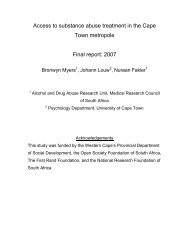Audit of Substance Abuse Treatment Facilities in ... - SA HealthInfo
Audit of Substance Abuse Treatment Facilities in ... - SA HealthInfo
Audit of Substance Abuse Treatment Facilities in ... - SA HealthInfo
- No tags were found...
You also want an ePaper? Increase the reach of your titles
YUMPU automatically turns print PDFs into web optimized ePapers that Google loves.
small proportion <strong>of</strong> South African drug users are <strong>in</strong>jection drug users (Dew<strong>in</strong>g et al.,2006), <strong>in</strong>jection drug users still face many health risks that can be ameliorated throughtimeous <strong>in</strong>terventions. In addition, less than half <strong>of</strong> the facilities test for and conduct<strong>in</strong>terventions to reduce the risk <strong>of</strong> HIV. This f<strong>in</strong>d<strong>in</strong>g is <strong>of</strong> greater concern, especiallygiven the strong association between substance abuse and risky sexual practices(Wechsberg, Craddock, & Hubbard, 1998) and South Africa’s high HIV prevalence rate.4.3. TARGETING BARRIERS TO TREATMENT ENTRY, ENGAGEMENTAND RETENTION FOR CLIENTS FROM UNDERSERVED GROUPSInternational pr<strong>in</strong>ciples <strong>of</strong> effective treatment for substance use disorders (NIDA, 2006)and South African norms and standards for <strong>in</strong>patient and outpatient treatment emphasisethat substance abuse treatment services should be (i) accessible to <strong>in</strong>dividuals who needand want services and (ii) appropriate for different cultural, age and gender groups.Despite these standards and widespread concern about the accessibility andappropriateness <strong>of</strong> exist<strong>in</strong>g treatment services for clients from historically underservedgroups (Myers & Parry, 2005), South African substance abuse treatment facilitiesgenerally fail to meet these standards. The follow<strong>in</strong>g sections describe the accessibilityand appropriateness <strong>of</strong> substance abuse treatment services with particular reference tohistorically underserved population groups; namely Black/African substance users andwomen.4.3.1. The extent to which services are accessible to underserved groupsF<strong>in</strong>d<strong>in</strong>gs show that <strong>in</strong> Free State, Limpopo, Mpumalanga and North West, Black/Africanclients cont<strong>in</strong>ue to be under-represented <strong>in</strong> substance abuse treatment facilities. AlthoughBlack/African persons comprise about 84.0% <strong>of</strong> the general population <strong>of</strong> Free State(Statistics South Africa, 1998a), they comprise only 31.7% <strong>of</strong> the client population atsubstance abuse treatment facilities <strong>in</strong> this prov<strong>in</strong>ce. Similarly, while Black/Africanpersons comprise about 97.3% <strong>of</strong> the general population <strong>in</strong> Limpopo (Statistics SouthAfrica, 2006b), they comprise about 48.0% <strong>of</strong> the client population at substance abusetreatment facilities <strong>in</strong> this prov<strong>in</strong>ce. In Mpumalanga, Black/African persons compriseabout 92.4% <strong>of</strong> the general population (Statistics South Africa, 2006c) while only 48.5%<strong>of</strong> the client population are <strong>in</strong> treatment for substance abuse. Black/African personscomprise about 91.4% <strong>of</strong> the general population <strong>of</strong> North West (Statistics South Africa,69
















